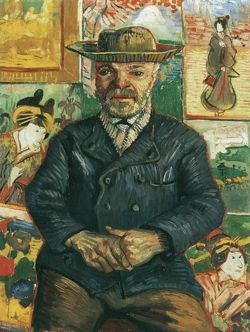
 |

|

| |
 |
 |
When van Gogh turned Japanese
Category - Old Master
Written by Kellie A. Hanna
Japan invaded Europe in the latter part of the 19th Century. It usurped the continent in the form of novelty, making its way into fashion, style, design, and, of course, art. When it came out of hiding at the Paris World Fair in 1867, Japan "burst upon the scene like a bombshell...," and made full use of Western ideas of "Oriental mystery." Paris quickly adopted the articles that were offered, and so Japan became the vogue. By 1891, critic Roger Marx "declared that Japan had been as important for modern art as classical antiquity had been for the Renaissance.
Many artists were satisfied with the attraction of the exotic and "added conspicuous, kitschy props...to their pictures...." Some imitated "the purity of Japanese interiors which (in their view) were properly devoid of anything superfluous."
Still, there were a few artists who went beyond the stylistic and modelled their lifestyles on Japan. Van Gogh--though he, too, spent some time in the kitschy development of the style--was one of those artists. "In Paris he went through the first three stages..." and later went in search of a "true Japan of his own." He would find it, and was to be forever influenced by his own development of this style.
Around 1885 in Antwerp, as he became increasingly interested in Japanese form, van Gogh started a large collection of Japanese woodcuts for his brother and himself. It wasn't long after this--in late winter 1887--that he painted Agostina Segatori Sitting in the Cafe' du Tambourin (oil, 1887). It in one can see that a number of Japanese woodcuts are merged with the green background. Apparantly it was at this point that van Gogh was still in the early stages of his adaption of Japanese flair to his paintings. While matching the "meditative" look of the figure and the tone of the piece, the woodcuts are, like the woman's hat, "exotic accessories."
Yet this beginning led to the appropriation of Japan within approximately six months, when van Gogh returned to one of his old tried-and-true study methods: imitation. He took on three Ukiyo (popular) subjects: Flowering Plum Tree and Bridge in the Rain--both by Hiroshige and from his own collection--and Oiran by Kesai Eisen. According to Metzger and Walther, it is thought that van Gogh was the first to try such copies, known as japonaiseries. This phase is known as his second in his affectation of Japanese culture. He chose those particular models "primarily to perfect his grasp of [color]."
His japanaiseries were his first attempt at using large areas of unmixed and unbroken color to their fullest extent and in their most vivid forms. Further, while the Impressionists that van Gogh had always admired and previously studied had removed black from their palettes, he "loved the sensuousness and symbolic power of black." Since it was a vital aspect to of the Japanese prints, van Gogh had the chance to utilize its power.
Later, as seen in his portraits of Pere Tanguy ( a long-time friend and supporter of van Gogh, Cezanne and Gauguin), van Gogh further developed and gave life to his use of Japanese style and form. In them, "[he] boldly attempts no less than than a synthesis of oriental and western art...[an attempt] that is far beyond the syncretism of his early period...." While making use of a number of motifs, van Gogh moves away from re-creation with these portraits, and makes an effort to express his vision thematically.
By 1888, in Arles, van Gogh was to determine that "'My whole work is founded on the Japanese...." One needs only to look at his orange blossom paintings from that period to see that this is true.

Metzger, Rainer, and Ingo F. Walther. Van Gogh. Cologne:
Taschen, 1996.
~Related Web sites for this Feature~ ~top~
|
membership
| gallery | interact
| resources | search
| company
Copyright 1995/2002, Artwell. All rights reserved.
Artwell, Artwell.com, The Artesian Well, WebChat@TheWell, The Artist's Haven, Find your inspiration, and the elipse logo are all trademarks of Artwell Inc. |
|
 |


